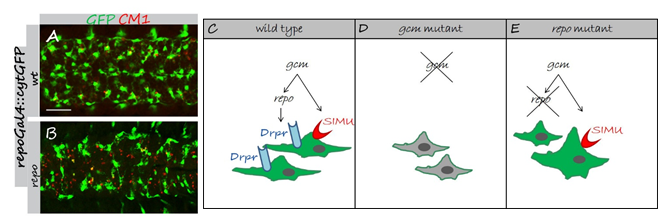Project 2
Establishment of phagocytic ability
Phagocytes must recognize apoptotic cells with high level of specificity in order to remove apoptotic but not living cells. This very precise discrimination is achieved through transmembrane phagocytic receptors or secreted bridging molecules, which recognize specific targets on apoptotic surfaces. Importantly, most of the receptors are exclusively expressed in phagocytic cell populations. We are interested in molecular mechanisms that control the establishment of phagocytic ability in developing glia and macrophages. Our studies demonstrate that glial phagocytic ability is determined by a developmental program responsible for the specific expression and function of two glial phagocytic receptors, Six-Microns-Under (SIMU) and Draper. Undifferentiated glial cells in repo mutant embryos exhibit abnormal expression of SIMU and Draper resulting in abnormal phagocytosis of apoptotic cells. Current research focuses on molecular mechanisms governing establishment of phagocytic ability in embryonic macrophages.
Developmental regulation of glial phagocytic ability during embryogenesis.
(A,B) Projections from confocal stacks of the CNS at embryonic stage 16, ventral view; apoptotic cells are in red (CM1) and glia in green (repoGal4::cytGFP). Bar, 20 µm. In wild type embryo (A) apoptotic particles are mostly inside GFP-positive glia. In repo mutant embryo (B) many apoptotic particles are outside GFP-positive glia. (C-E) Schematic summary of developmental regulation on SIMU and Draper expression in embryonic glia. (C) Wild type. (D) In gcm mutant no glia are formed and no SIMU and Draper expression is found in cells, which turn from glia to neurons. (E) repo mutant glia appear in abnormal shapes. SIMU is expressed on some glial cells, which are often bigger than wild type glia and show macrophage-like behavior.
